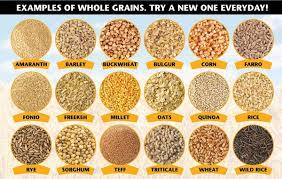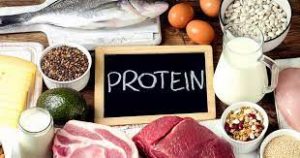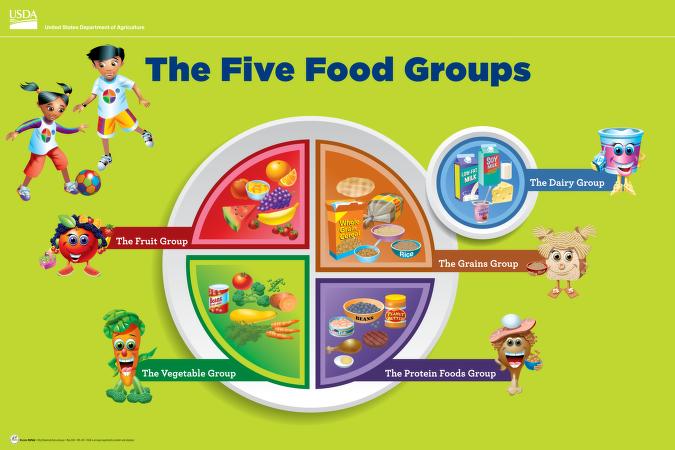

The 5 Food Groups: Healthy food & nutrition Basic: Food is important for survival because it provides vital nutrients and helps the body function and remain healthy. Nutrients may be divided into two types: macronutrients, and micronutrients. Now let’s understand some healthy food nutrition basics.
Macronutrients are nutrients that the body requires in significant amounts. They provide energy (calories) to the body. These include proteins, carbohydrates, and fats that provide calories to fuel and energize the body but play a specific role in maintaining health. Micronutrients are small quantities of nutrients that the body needs.
It might be simpler than you think to eat a balanced diet. Just keep the food groups in mind! when you plan or prepare meals and snacks. Try to include choices from all the food groups that meet your calorie and nutrient needs. when you plan or prepare meals and snacks.
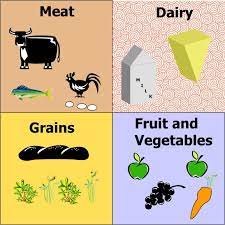
The 5 Food Groups Pyramid: Sample Choices List:
Understand some healthy food nutrition basics: There are D food groups. Every food group needs to be provided with essential nutrients and energy that can support normal growth and good health. Choose foods with a high nutrient content (protein, vitamins, and minerals) in comparison to their calorie, fat, and sodium content.
What are the seven major food groups?
The body requires seven different types of nutrition basics. Examples include carbohydrates, proteins, fats, vitamins, minerals, fiber, and water. Everyone should consume these seven nutrients on a regular basis to aid in the development of their bodies and the maintenance of their health.
FOOD GROUPS Pyramid | Nutrition Basics
Foods are arranged in the pyramid in a way that demonstrates their importance to human health. We should eat more of the items at the bottom of the food pyramid than the foods at the top.
Consider whole fruits: Chart and List:
Eating fruits provides vital essential nutrients for health, such as potassium, dietary fiber, vitamin C, and folate. Focus on whole fruits – fresh, canned, frozen, or dried instead of juice. Pay attention to the sugar found in fruits naturally is not counted in terms of added sugar. People who eat most vegetables and fruits on an overall healthy diet have a lower risk of some chronic diseases.
Fat, sodium, and calorie content are all naturally low in most fruits. By substituting fiber-rich, low-calorie fresh fruit for higher-calorie foods, you can lower your total calorie intake.
Use these food groups tips to add fruit to your day:
- Add fruit to your breakfast: add bananas or sliced apples to pancakes, or blend raisins with hot oatmeal.
- Fruits are a delicious way to add more nutrients to your snacks and meals. Dried fruits with nuts or whole fruits, such as apples, are good options. They are simple to transport and store. Kids love the bright flavors, beautiful colors, and various shapes and size that they come in.
- Add high-grain cereals, bananas, or sliced apples to pancakes with your favorite seasonal fruit, or mix raisins in hot oatmeal.
- Keep fruits healthy: Rinse fruits then dry with a clean towel before preparing or eating them. Rub fruits strongly under running water to remove dust and surface microorganisms.
- Cut-up fruit can be kept in the refrigerator for later use. Place the bowl in front of the shelf, so it’s the first thing you see when you open the door to Food Groups.
- When fresh fruits are in season, they are often less expensive and at their peak flavor.
- Purchase dried, frozen, and canned fruits (in water or 100% juice) in addition to fresh fruits to ensure that you still have some on hand.
- Try pre-cut fruit packages (such as melon or pineapple chunks) to make a fast and nutritious snack.
- Choose fruits that haven’t been added sugars or fruits that have been canned in fruit juice rather than syrup.
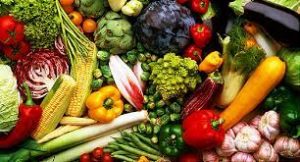
Vary your veggies: Nutrition Basics
Vegetables aren’t always made equal. Seriously! Dark-green vegetables, red and orange vegetables, legumes (beans and peas), and starchy vegetables are divided into four categories.
Take a look at these tips to learn how to incorporate more vegetables into your daily routine and how to prepare these delicious treats in your kitchen:
- Make an omelet or a breakfast wrap with leftover cooked vegetables to start your day. Optionally, mix spinach into a morning smoothie for a boost of flavor and protein.
- Add variety to salads: Salads can be made more colorful (and tasty) by adding corn kernels, radish slices, or diced red onions. Seasonal vegetables are a perfect way to add variety to your diet all year.
- Add variety to salads: Salads can be made more colorful (and tasty) by adding corn kernels, radish slices, or diced red onions. Seasonal vegetables are a perfect way to add variety to your diet all year.
- Consider a stir-fry: For a fast dinner, stir-fry carrots, shredded cabbage, greens, and low-sodium jarred mushrooms Food Groups. To make a (possibly) fresh and different protein source, add some tofu.
- Spruce up your sandwich: Make your sandwich more delicious by adding spinach or thinly sliced sweet onions to your favorite sandwich or wrap for a spicy crunch.
- Go for a dip or a dunk: With a homemade Italian dressing or dipped in a low-fat dip or hummus, serve baked potato wedges, cucumber slices, or cauliflower sticks.
- Take vegetables on the go: Take some crunchy carrot, celery, or jicama sticks with you. A quick snack is a small container of cherry tomatoes or sugar snap peas.
- Fresh vegetables should be purchased while they are in season. They are less expensive and are more likely to be at their best flavor.
- Look into farmers’ markets for cheaper vegetables, particularly with SNAP benefits.
- Keep frozen vegetables on hand for fast and simple cooking without the need to chop!
- Invest in easy-to-prepare vegetables. Pick up pre-washed salad greens and add baby carrots or grape tomatoes for a fast salad. For fast snacks, buy ready-to-eat packages of vegetables like baby carrots or celery sticks.
- To easily “zap” vegetables, use a microwave. This is a fast way to cook potatoes or sweet potatoes.
- To keep meals fun, mix up the vegetables you use.
- Crunchy vegetables can be consumed raw or lightly steamed.
Make half your grains whole grains: Nutrition Basics
Whole grains and processed grains are the two subgroups of grains. Whole grains include the entire grain kernel—the germ, bran, and endosperm.
A grain product made from wheat, oats, rice, cornmeal, barley, or some other cereal grain is referred to as a grain product Food Groups. Bread, pasta, oatmeal, breakfast cereals, tortillas, and grits are only a few examples. White flour, white rice, and white bread are examples of refined grains.
Here are 10 tips that will help you eat whole grains:
- Check for fiber on the label: Whole-grain foods’ fiber content can be found on the Nutrition Basics Facts label. Fiber sources that are good supply 10% to 19% of the Daily Value; outstanding sources contain 20% or more.
- Whole grains can be healthy snacks: Popcorn is a whole grain that can be used as a nutritious snack. Make it with very little butter and salt.
- Make simple switches: Substitute a whole-grain product for a refined-grain product to make half of your grains whole grains. For example, instead of white bread or bagels, eat 100 percent whole-wheat bread or bagels, or brown rice instead of white rice.
- Whole grains should account for at least half of the grains: Whole grains are rich in nutrients and can help lower cholesterol levels, as well as the risk of heart disease, obesity, and diabetes. Fiber from whole grains is also helpful to bowel function.
- To feel satisfied when eating fewer calories, choose whole grains.
- Let your kids assist you in preparing a whole-grain side dish. The more involved they are in the preparation of a meal, the more interested they will be in eating it.
- Make it a habit to read the Nutrition Basics Facts label on any product you buy. Check to see if you’re eating whole grains. Look for the words “whole grains” or “whole wheat” in the first ingredient.
- Try eating whole grain snacks. Whole-grain cereal, whole grain crackers, and popcorn made without salt or butter fit into that category.
Vary your protein routine: Nutrition Basics
Animal (meat, poultry, fish, and eggs) and plant (beans, peas, soy products, nuts, and seeds) sources of protein are available. We all need protein—But how much is enough? Protein foods can be consumed in 5 to 7 ounces* a day by most people aged 9 and up.
Choose a range of protein foods to get some of the nutrients your body needs and to improve your health.
Corn, peas, and soy products are good choices as a main dish or part of a meal. As a snack, on salads, or in main dishes, choose unsalted nuts. Nuts should be used in place of, not in addition to, meat or poultry.
Make a range of protein food groups options by following these tips:
- Include protein in your snack: Try dipping apple or celery slices in peanut or nut butter, or spreading it on whole-grain crackers. A hard-boiled (hard-cooked) egg with a splash of pepper is also a healthy source of protein.
- Keep seafood on hand: Seafood from containers, such as salmon, tuna, or crab, is easy to cook and consume. Canned foods also keep well.
- Add protein to your salad: A salad of mixed greens with grilled chicken or shrimp provides flavor and protein. Chickpeas or black beans are both tasty and cost-effective choices.
- Ground beef that is lean is the best choice: The product must be at least 92 percent lean/8 percent fat to be considered “lean.”
- Skinless chicken parts are essential, or the skin can be removed before cooking.
- The leanest poultry options are boneless skinless chicken breasts and turkey cutlets.
- Leaner is better. The leanest beef cuts are round steaks and roasts (eye of round, top round, bottom round, round tip), top loin, top sirloin, and chuck shoulder and arm roasts.
- Ham, pork loin, tenderloin, and middle loin are the leanest pork cuts.
- Instead of lunch/deli meats with more fat, such as standard bologna or salami, select lean turkey, roast beef, ham, or low-fat lunchmeats for sandwiches.
- Choose seafood as your key protein source at least twice a week. Seafood high in omega-3 fatty acids, such as salmon, trout, and herring, should be avoided.
- Corn, peas, and soy items may be used as a main dish or a side dish.
*Note: The Vegetable Group also includes beans and peas.
Dairy every day: Nutrition Basics
Dairy is delicious and nutritious, particularly low-fat or fat-free varieties. They are the best sources of calcium, protein, and vitamins A and D. However, a lot of dairy products have a lot of fat in them. Some people find them difficult to digest. As a result, go for low-fat dairy or dairy alternatives. Increasing your daily consumption is as simple as drinking milk, eating yogurt, and cheese, or choosing non-animal foods and beverages like soymilk.
How much dairy food is needed on a daily basis?
Your daily dairy group requirements are determined by your age, gender, height, weight, and level of physical activity. The sum varies for women depending on whether they are pregnant or breastfeeding.
Here are some tasty and nutritious ways to have more dairy in your diet: Drink milk or soymilk with your meals. Choose low-fat or fat-free milk.
- If you normally drink whole milk, make the move to fat-free milk gradually to reduce saturated fat and calories. Reduced fat (2%) is a good place to start, followed by low-fat milk and yogurt (1%) and finally fat-free (skim).
- Oatmeal and hot cereals can be made with fat-free or low-fat milk instead of water.
- When making condensed cream soups, use fat-free or low-fat milk (such as cream of tomato).
- Take a snack on fat-free or low-fat yogurt.
- Yogurt may be used to make a fruit or vegetable dip.
- In a blender, make fruit-yogurt smoothies.
- For a short dessert, top cut-up fruit with flavored yogurt.
- Shredded reduced-fat or low-fat cheese can be sprinkled on casseroles, soups, stews, or vegetables.
- Make a fat-free or low-fat yogurt topping for a baked potato.
Changing your overall eating pattern in tiny, easy ways will help you and your family remain healthy. Know the basics of good nutrition and how to choose balanced foods and beverages. Healthy food nutrition. Hope You understand some healthy food groups’ nutrition basics.


